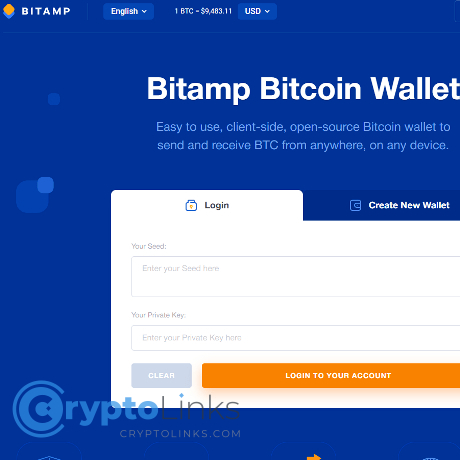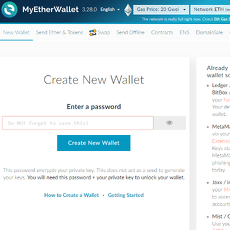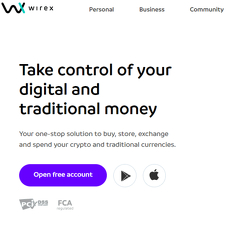Bitamp Review
Bitamp
www.bitamp.com
Bitamp Wallet Review Guide: Everything You Need to Know Before You Start Using It
Ever found yourself scrolling through forums, typing “best Bitcoin wallet” into Google, wondering if you’ll ever get a straight answer? The truth is, picking the right crypto wallet can feel confusing—and it probably shouldn’t be that way. With dozens of wallets all shouting about being “the safest” or “most private,” how do you figure out which one actually lives up to the hype, and which ones are just marketing noise?
You’re not the only one searching for a wallet that’s actually secure, easy to use, and not a pain to set up. Over the past year, I’ve seen more people than ever second-guessing their wallet picks, especially with high-profile hacks making headlines and new wallet apps launching each week. As more of us jump into crypto for the first time—or look for something better—the wallet landscape isn’t getting any simpler.
The Struggles of Picking a Crypto Wallet in 2025
Let’s be honest: choosing a crypto wallet these days is a minefield. Security stories pop up in the news so often that you start to wonder if any wallet can be truly safe. Everyone wants to keep their Bitcoin out of reach from thieves, scammers, and even nosy corporations. But between hardware wallets, mobile apps, online tools, and all the different “must-have” features, it’s easy to feel totally lost.
And here’s the worst part—most “best wallet” lists just toss out jargon and give you the same recycled advice. But you want to know:
- What actually makes a wallet secure?
- Which wallets respect your privacy?
- Can you really trust new wallets like Bitamp—or are the classics always best?
- Is setting up a wallet going to take hours…or minutes?
I get questions like these all the time. And if you’re feeling a little overwhelmed by it all, you’re not alone. Even seasoned Bitcoiners sometimes wonder if they could be doing things better.
What This Guide Will Help You Fix
Lots of reviews skim the surface, never answering the questions real people actually have. I want to change that here. So whether you’re new to Bitcoin or just tired of over-complicated wallets, I’m here to share what really matters:
- The wallet basics no one explains (but everyone should know)
- How to spot a wallet that actually fits your needs
- What’s unique—in a good or bad way—about Bitamp
- Why your choice might seriously affect your privacy, not just your Bitcoin
I'll be sharing what I’ve learned, plus the most genuine questions people are asking on Reddit, Twitter, and everywhere else people talk Bitcoin. Because the last thing anyone needs is to lose coins to a bad wallet pick.
Does Bitamp fit the bill?
Here's the big question: is Bitamp one of those rare wallets that really makes life easier—or is it just another “me too” project? If you care about privacy, speed, and keeping things simple (without giving up control to a faceless company), Bitamp claims to tick all those boxes. But are those claims legit?
Stick around, because next, I’ll break down the basics behind crypto wallets—the real risks and rewards—to get you ready to make smarter decisions (and avoid common mistakes that trip up even experienced Bitcoin holders). What exactly should you care about before handing over your precious coins to any wallet, including Bitamp? Let’s find out.
What Is a Crypto Wallet and Why Should You Care?
Let’s zoom out for a second. If you’ve been hearing “crypto wallet” used like it’s common knowledge, but you still wonder what it is (or why you should even bother with one), you’re absolutely not alone. Here’s a quick fact: losing access to your crypto wallet can mean losing all your Bitcoin—forever. That’s because your wallet is way more than a place to stash coins. It’s where the magic of “being your own bank” happens.
"Not your keys, not your coins." — Probably every crypto veteran, ever.
This isn’t just a catchy phrase. The wallet you choose is literally the difference between total control and zero control. Think of your crypto wallet as your passport, vault, and key—all rolled into one tiny (sometimes digital) package.
Types of Crypto Wallets: What Are Your Options?
Okay, wallet shopping in 2025 feels a bit like staring at dozens of different power tools with no labels. There are software wallets (apps, web, or desktop programs), hardware wallets (USB-like gadgets), mobile wallets (your phone!), paper wallets (old-school printouts), and web-based wallets, which is Bitamp’s category.
- Software wallets: These are easy to use and quick to set up—think smartphone apps or programs you run on your computer. Perfect for everyday transactions but watch out for malware.
- Hardware wallets: Physical devices that store your coins offline. They're crazy secure (almost immune to online hacks), but lose one—plus the backup—and it’s game over.
- Mobile wallets: A type of software wallet built for speed and convenience. Great for checking your balance on the fly or quick payments, but risky if your phone gets compromised.
- Paper wallets: Literally a piece of paper with your keys on it. Old-school and rarely used now, but fun trivia!
- Web wallets: Like Bitamp. Here, your wallet’s generated and accessed right in your browser. No software installs, no fuss—just your passphrase and you.
So, what’s the big deal with Bitamp being a web wallet? You don’t need to install anything. You just show up, create your wallet, and you’re in business. But that ease comes with its own set of things to watch for…
Security Concerns: How Safe Are Crypto Wallets?
Here’s where it gets real. “Are web wallets secure?” pops up every single week in crypto forums. All wallets are about private keys—long strings of numbers that unlock your coins. Lose the key, or let someone else snag it? Your Bitcoin’s gone.
There’s a big difference between custodial (someone else holds your keys, like an online exchange) and non-custodial wallets (you and only you control the keys). Bitamp is non-custodial, but not all web wallets are. Every type has its risks:
- Phishing attacks: Fake websites and sneaky links are everywhere. One wrong click and your funds could be gone.
- Device security: If your device is already compromised with malware, it doesn’t matter which wallet you pick. Your keys are toast.
- Backup fails: Didn’t write down your recovery phrase? Or kept it on your desktop? Backups are boring—until you need them.
Researchers at Chainalysis found that crypto wallet theft is still a $1 billion+ problem every year, and it’s usually linked to user mistakes or shortcuts. That’s why the little details—secure key generation, open-source code, no sketchy downloads—matter more than ever.
Factors to Consider When Picking Any Crypto Wallet
Here’s a fun truth: the “best Bitcoin wallet” isn’t the one with the most coins or wildest features. For most people, it’s about a balance of a few basics:
- Security features — Does it put you in control? Is it open source?
- Accessibility — Can you use it anywhere? Does it feel too techy?
- Supported coins — Do you just want Bitcoin, or are you planning to jump into altcoins too?
- Updates & community support — Is the wallet well-loved or a forgotten project?
- Bonus features — Charts, buy/sell options, address books… or do you just care about sending and receiving Bitcoin, fast?
It’s easy to get lured by wallets that promise everything, but for storing Bitcoin securely—and keeping things stress-free—it might pay to look at simple, privacy-first options. Does Bitamp tick those boxes?
I’ll show you exactly how Bitamp works, why it’s getting buzz (or skepticism), and what makes it stand out from the crowd. Want to know if Bitamp quietly solves the headaches that most wallets cause? Stick with me—the real secrets are next.
Introducing Bitamp: Quick Overview
So, you’re in the thick of searching for a Bitcoin wallet that actually makes sense in this wild crypto landscape. Bitamp is probably popping up on your radar for good reason—its name keeps buzzing on Reddit, Twitter, and the privacy corners of the web. But what’s all the fuss about? Let’s pull back the curtain and get a feel for what Bitamp truly offers.
What Kind of Wallet Is Bitamp?
Bitamp is a non-custodial, web-based Bitcoin wallet. No registration, no KYC, and no handing over personal details. You load their website, generate a wallet, and instantly access your keys—and only you have control. Seriously, it’s that direct (“your keys, your coins” in action).
Here’s why this matters: Too many wallets force you into accounts, apps, or even tracking cookies. Bitamp says, “Nah, you’re in charge.” It’s refreshingly barebones. As one user on Bitcointalk forums put it:
“Bitamp just lets you hold your BTC without jumping through hoops. No weird logins, just straight to the point.”
That no-account setup helps kill a bunch of privacy headaches. Just make sure you’re paying attention to the other side of the coin—which I’ll talk about in the next section.
How Does Bitamp Work?
The process is almost too simple for its own good. Here’s how it breaks down:
- Visit bitamp.com using any web browser (desktop or mobile, it’s all good).
- Right away, the site lets you create a brand-new Bitcoin wallet—no personal info, no waiting.
- You get a recovery phrase (aka seed phrase). Write this down. This is your lifeline to your coins. Nobody else sees it—not even Bitamp.
- Your wallet (and private keys) are generated and stored locally in your browser—never sent to the cloud. Nothing is held on Bitamp’s servers.
Backups? The seed phrase is how you restore your wallet on any device, at any time. There’s no “forgot password” button and no magic support ticket for lost seeds—just you and your secret phrase.
Because everything happens client-side (inside your own browser), you get an extra layer of privacy, as long as you keep your device clean and secure.
What Makes Bitamp Different from Other Bitcoin Wallets?
In a world stuffed with crypto wallets, Bitamp cuts through the noise by actually sticking to simplicity and privacy. Here’s what I notice stands out:
- No Registration, Ever: You create and access your wallet instantly—no name, no email, no logs. Heck, there are wallets out there that still want your phone number. Not here.
- Fully Open Source: Every line of Bitamp’s code is up for public review on GitHub. There’s no “black box”. If you’re the DIY type, you can even run Bitamp from your own saved copy (offline) for ultimate security.
- Privacy First by Design: Since there’s no account, there’s nothing tying you to your wallet except the keys you control. There’s no server-side history or data collection chilling in the background.
- One-Track Focus: Bitamp is 100% devoted to Bitcoin—no distractions, no altcoin juggling, and zero bloat. It’s for people who want pure BTC, period.
When you look at most online wallets—think Blockchain.com, Coinbase Wallet, or even some browser extensions—they’ll usually ask for sign-ups or hold at least some info about you “for your security.” With Bitamp, it’s basically, “Here are the keys, don’t mess it up.”
This niche approach attracts a loyal following from privacy lovers and those who hate red tape. Caution: the responsibility is fully on your shoulders. “Simple” doesn’t mean “forgiving”—more on the risks (and how to dodge them) coming right up.
Ever wondered what really keeps your Bitcoin safe when you use a web-based wallet like Bitamp? I’m going to strip back the marketing and show you what happens under the hood, what you can trust—and what you absolutely need to watch out for. Don’t click away, because you’ll want to see how Bitamp handles security and whether it’s enough in 2025.
Security Breakdown: Is Bitamp Safe?
When you’re putting your hard-earned Bitcoin somewhere, “Is this safe?” isn’t just a question—it’s the question. I get it. The last thing you want is to become the next cautionary tale that gets sent around Reddit. So let’s really look into Bitamp’s security promises and the real-world stuff you have to think about.
How Does Bitamp Keep Your Bitcoin Secure?
Bitamp goes for a “no trust, no problem” vibe. Here’s what stands out:
- Client-side key generation: When you create a wallet on Bitamp, your private key is generated right in your web browser—never sent over the internet, not stored on their servers, not seen by anyone but you. Technically, this means Bitamp can’t touch your keys, even if they wanted to.
- Open-source code: Anyone can check the code that runs on Bitamp at any time, over at their GitHub. That’s huge for transparency. (Look up the “Linus’s Law” rule: “Given enough eyeballs, all bugs are shallow.” It means bugs and backdoors are much harder to hide when the code is public.)
- No registration required: No accounts, no personal data. All you need is your seed phrase. That’s less attack surface if someone breaches Bitamp itself—there’s nothing about you stored there to leak.
Sound pretty solid so far, right? But no tool is invincible. One of the Achilles’ heels with any web wallet is phishing: if you land on a fake Bitamp site, it could steal your keys. Make it a habit to bookmark the correct URL (and double-check for “https://bitamp.com”). Browser malware is another lurking risk, so make sure you use a clean, up-to-date browser and consider an ad blocker and anti-virus.
“The best security often comes down to human choices, not just code.”
In fact, a study by Chainalysis showed that phishing and targeted malware are responsible for over 60% of Bitcoin wallet thefts each year. That’s not a knock against Bitamp itself—but it’s a reminder: your habits matter as much as the wallet’s software.
Self-Custody Explained: The Good, the Bad, the Responsibility
Security and responsibility ride together. Bitamp lives and breathes “self-custody”: no one else, not Bitamp, not hackers at Bitamp (even if they existed), not the government, nobody can access your wallet unless they have your recovery phrase or private key.
- Upside: You’re not asking permission from a company, and there’s no risk of a central hack emptying user balances.
- Downside: Lose your backup phrase or let someone else get it, and your Bitcoin is gone—forever. There is no customer support rescue. This is empowering but can be nerve-wracking for newcomers.
A real example? Just last year, a friend of mine lost access to his entire wallet because he tucked his seed phrase in a “secure” notes app, which was then synced and compromised. That’s not Bitamp’s fault—it’s the trade-off for true self-ownership.
Frequently Asked: “Can Bitamp Be Hacked or Shut Down?”
Here’s what people really want to know (if that’s you, you’re not alone):
- Can Bitamp get hacked? The website is a potential target, sure, but your keys aren’t stored there. If you use a compromised device or visit a scam copy, you’re at risk—just like with any web wallet. Bookmark the real thing and protect your device.
- What if Bitamp goes offline? The magic of open-source and non-custody: as long as you have your recovery phrase or private key, you can restore your wallet and your Bitcoin using any other compatible Bitcoin wallet (like Electrum or Wasabi). Bitamp disappearing does not mean your Bitcoin disappears.
- Can Bitamp freeze my funds or block me? No. Bitamp never sees or controls your coins. You hold your keys, you sign your transactions, you’re in charge.
So, does “no registration, no data” mean perfect safety? Not quite: you are the final firewall. But if you want privacy and control, it’s hard to beat this setup for pure, old-school Bitcoin self-reliance.
Wondering how those security choices actually feel when you’re using Bitamp every day? Can “simple and secure” really be as smooth as it sounds… or do you need ninja skills to pull it off? Let’s take a real look at using Bitamp day-to-day—coming up next.
Features and User Experience: Using Bitamp Day-to-Day
One thing that caught my attention when trying out Bitamp? It’s clean, minimal, and doesn’t drown you in options. Sometimes, that’s exactly what you want—especially if you’re just starting out or you’re just sick of over-complicated crypto tools.
How Easy Is It to Set Up and Use Bitamp?
Getting started with Bitamp is like making instant coffee—it’s that quick. Here’s what happens:
- Go to the Bitamp site. There’s no sign-up or email request. You don’t even create a password for their servers (because there are none).
- Click “Create New Wallet.” Instantly, you’re shown your 12-word recovery phrase (don’t skip that backup, because this is all that stands between you and your Bitcoin).
- Write it down, store it safely. Don’t screenshot it. Don’t email it to yourself.
- Start sending or receiving Bitcoin. The dashboard is straightforward: you see your Bitcoin address, your balance (updates with each transaction), and instant options for sending or receiving.
Looking online, most beginners say their biggest hang-up comes in two places—copying the recovery phrase correctly, and understanding there’s no “forgot password” magic. Once you grasp that it’s truly self-custodial, it clicks.
"With Bitamp, you realize your Bitcoin is finally yours—nobody can help if you lose your keys, but also, nobody can freeze your funds.”
Can You Access Bitamp from Anywhere?
One of the things that makes me come back to Bitamp (and recommend it to crypto newbies) is the pure flexibility. Any modern browser works—Chrome, Firefox, Brave, Edge, and yes, even on your phone’s browser. No downloads, installs, or waiting for the “app to update.”
- Works on laptops, desktops, tablets, or smartphones.
- No geoblocking. It’s not specifically targeting or rejecting any country. If you can access the web, you can access your wallet.
For travelers, digital nomads, or just people who hop devices a lot, this means your Bitcoin wallet stays accessible—but only to you, only when you enter your recovery phrase. No syncing headaches, no “device registration.”
Limitations You Should Know About
Now, let’s be real. Bitamp is a pure-blooded Bitcoin wallet. Don’t expect to juggle Ethereum or meme coins here—if you’re hunting for an all-in-one solution, this isn’t it. Also, no integrated price charts, staking tools, or widgets.
- No multi-coin support. It’s BTC or bust (which, honestly, some people prefer for security’s sake).
- No extras. You won’t find spending analytics, push notifications, or hardware integrations.
- Manual backup only. Lose your recovery phrase, lose access—no emailing support for rescue.
This simplicity isn’t everyone’s cup of tea, but for privacy lovers and “keep it simple” fans? It’s exactly what they're after.
How Does Bitamp Compare for Fees and Speed?
Here’s something you’ll love reading: Bitamp itself doesn’t charge you anything to create or use a wallet. No premium plan, no hidden subscription. The only thing you pay are Bitcoin network fees (which you get to adjust, by the way—set a higher or lower fee depending on how fast you want your transaction processed, just like any savvy Bitcoiner).
- Completely free to use. No strings attached.
- You choose network fees. If you’re in a rush, bump it up; if not, set it low and wait.
That’s pretty rare. Some browser wallets sneak in “convenience” or withdrawal fees, but Bitamp plays it straight. Transactions are as fast as the Bitcoin network itself—no bonus lag from Bitamp’s side.
Real talk: most of us come to Bitcoin for two reasons—freedom and control. Bitamp’s day-to-day use genuinely reflects both. But... what happens when you stack Bitamp next to the giants of the wallet world? Spoiler: the truth might surprise you. Ready to see how it compares? Let’s put it head-to-head with the best-known Bitcoin wallets next.
Bitamp vs Other Popular Bitcoin Wallets
Now for the real question bouncing around your mind: How does Bitamp really stand up against the big names—think Electrum, Blockchain.com, and the ever-popular Trust Wallet? Here’s where the choice gets interesting, especially if you’re not in love with complexity or endless features you’ll never use.
Quick Comparison Table
| Wallet | Privacy | User Control | Ease of Use | Fees |
|---|---|---|---|---|
| Bitamp | Excellent (no registration, minimal tracking) | Full self-custody | Super simple (browser-based) | Free (just pay network fees) |
| Electrum | Great, but some features require advanced setup | Full self-custody | Geared for power users | Free (network fees only) |
| Blockchain.com Wallet | Good, but uses email signups | Custodial/non-custodial mix | Beginner-friendly app/web | Free for basic use (network fees) |
| Trust Wallet | Good, but collects analytics | Full self-custody | Mobile-focused, user-friendly | Free (network fees only) |
Where Bitamp Excels—and Where It Doesn’t
Here's the bottom line. Bitamp hits a sweet spot if you crave:
- Privacy-first design: There’s literally no signup, email, or KYC (Know Your Customer) checks.
- Super-fast access: No downloads or waiting for blockchain syncing.
- Minimalism: Just Bitcoin. No chart clutter, no “invest” tab trying to sell you something extra.
Real talk—sometimes less is so much more. If all you want to do is send, receive, and check Bitcoin without someone asking for your grandma’s maiden name, Bitamp just feels lighter.
But where does it fall short?
- No multi-coin support: If you like dabbling in altcoins, NFTs, or staking tokens, you’ll need another wallet.
- Self-custody risk: Lose your recovery phrase? That’s game over, friend—there’s no customer service desk to call.
- Lacks bells and whistles: No hardware wallet pairing, definitely no portfolio management.
This is why I always say: “Bitamp is for those who want to stay low-key and fully in control—just pure Bitcoin, straight up.”
What Crypto Industry Experts and Users Are Saying
I’m not the only one who’s noticed Bitamp’s quirks. Here’s what’s echoing through Reddit forums, GitHub threads, and user review boards:
- A crypto educator on X (formerly Twitter) admits:
“The open-source part is huge. You just can’t dismiss a wallet where you can actually see the code.”
- Some users love the speed: “I don’t want to sync for an hour—Bitamp is instant; load, send, done!”
- Security-minded folks point out: “If you know how to check browser URLs, self-custody is unbeatable, but for newbies? It might feel scary at first.”
- A few red flags pop up: “Make triple sure you’re on the real Bitamp site. Clones and phishing pages are out there.”
One thing I haven’t seen? Complaints about surprise wallet fees or hidden costs. Across the threads, the vibe is clear: Bitamp isn’t here to hold your hand or flood you with perks—it’s here to get out of your way. Still, transparency is a two-edged sword; if you’re not prepared, you carry all the risk yourself.
“With great power comes great responsibility.”
So, is Bitamp the right wallet for your everyday Bitcoin moves? Or is there something you still need to know before making it your go-to? If questions are piling up in your mind—such as “How safe is Bitamp for long-term storage?” or “What if I lose my backup?”—don’t worry. I have real, no-nonsense answers coming up, straight to the stuff people genuinely ask. Ready to see what most folks get wrong about Bitamp and the facts nobody tells you upfront? Trust me, you don’t want to miss this.
Frequently Asked Questions About Bitamp
Let’s cut through the noise—these are the questions that real people punch into Google when they’re deciding if Bitamp deserves a spot in their crypto toolbox. If you’re weighing your options, chances are you’re looking for reassurance on safety, privacy, or that little “what if?” scenario nobody wants to think about. Let’s tackle the burning questions, one by one.
Is Bitamp wallet safe for long-term storage?
Here’s the straight truth: Bitamp scores high on privacy and self-custody, but “safe” in crypto depends a lot on you. Since Bitamp is non-custodial, the site never holds your keys—you’re the only one with access. That’s powerful, but it also means there’s zero safety net. Lose your recovery phrase, and there’s no “forgot password” button. For long-term storage, it can be very safe if you follow proper backup habits (think: writing down your seed phrase and keeping it somewhere nobody can find but you). I’ve seen stories floating around Reddit—some users happily holding Bitcoin for years with wallets like Bitamp, others who lost coins just by misplacing their seed. Always remember:
“The safest wallet is only as good as your personal backup strategy.”
If you need ultra-long-term and don’t want the backup pressure, you might want to check hardware wallets too (I’ll show you when that makes sense in just a bit). Think about what fits your nerves—and your habits.
Is Bitamp completely anonymous?
This is huge for a lot of Bitcoiners. Bitamp doesn’t ask for your email, phone, or KYC info—so if you’re privacy-focused, this is a big plus. The web app runs client-side, meaning your keys are made right in your browser (never sent “to the cloud”). Bitamp doesn’t log transactions, IPs, or personal info—what you do with your coins is your own business. But let’s keep it real: Bitcoin itself isn’t fully anonymous. Blockchain analysis tools can track Bitcoin addresses. And your device or internet provider still knows you visited Bitamp’s site—so if you want digital invisibility, add tools like Tor or a VPN into your mix. In short, Bitamp maximizes privacy for a web wallet, but true “anonymity” is always a moving target.
What happens if I lose my recovery phrase?
This is the nightmare scenario nobody wants, but it’s the one you absolutely need to plan for. If you lose your recovery phrase (sometimes called a seed phrase), your Bitcoin is just…gone. Forever. Even Bitamp’s team can’t help; that’s how it works with non-custodial wallets. Your recovery phrase is your master key. Here’s what you should always do:
- Write it down on paper (don’t save it on your phone).
- Store it somewhere fireproof and waterproof—a safe, a bank deposit box, even a specialized “seed backup” metal plate if you want max security.
- Never share it with anyone, and never type it into any website except the official Bitamp wallet at bitamp.com.
Once it’s gone, your coins are unspendable. This rule applies to all non-custodial wallets, not just Bitamp. Spot the pattern? Your wallet, your rules... and your responsibility.
Can Bitamp access my Bitcoin or see my transaction history?
Short answer: No. Bitamp cannot access your coins or track your transactions. They never hold your keys and never host your funds. The wallet is open-source (so anyone can inspect how it works on GitHub), and all of your activity is managed right in your browser. You and only you control what’s going in and out. If you want another layer of trust, running Bitamp from the open-source code yourself is an option for the paranoid (no judgment—I get it!).
Other burning questions people ask
- Is Bitamp open source? Yes, 100%. Check their code on GitHub—no secrets, no obscure backdoors. That’s a huge plus for transparency-loving Bitcoiners.
- Does Bitamp charge fees? Not a cent to use the site. The only fees are the regular network Bitcoin miner fees when you send a transaction—same as with almost every wallet.
- Can I get support if I get stuck? Bitamp offers help through their website, but since you’re not handing over an account or personal details, don’t expect account recovery “miracles.” For bug reports or community help, their GitHub and support email are the go-to spots.
It’s wild how many myths still float around Bitcoin wallets like Bitamp. If you’ve got concerns bubbling up or if some of these answers got you thinking twice, don’t worry—I’m about to lay out exactly what type of crypto fans Bitamp is actually “built for.”
Ever wondered whether you actually fit that sweet spot, or if you’d be happier with something else? Trust me, you’ll want to keep reading…
When Does Bitamp Make Sense (and When Not)?
Choosing the right Bitcoin wallet is a big deal. The sheer number of wallets out there—and the weekly horror stories of hacks or accidental loss—make it easy to second-guess where to stash your Satoshis. Bitamp is a unique beast in this jungle, but it's not the answer for every single Bitcoiner out there. Here’s a reality check to help you figure out if Bitamp is actually the best fit for you, or if you’d be better served exploring elsewhere.
Bitamp Is Best For…
Bitamp does a handful of things really, really well. Here’s who will get the most out of this wallet:
- Privacy believers: If the thought of handing over your name, email, or even phone number to a wallet provider makes your skin crawl, Bitamp’s “no registration, no trace” approach is a breath of fresh air. No logins. No tracking. Your business is your business.
- Bitcoin purists: Bitamp is focused solely on Bitcoin. If BTC is your only treasure and you like the idea of open-source software handling your private keys, this is right up your alley.
- Beginners who want things SIMPLE: Zero setup hoops, no software to install, and a clean interface. If the word “seed phrase” still makes you a little nervous, Bitamp’s step-by-step onboarding keeps things from feeling overwhelming.
- Mobile multitaskers & world travelers: Since Bitamp is browser-based and not geo-blocked, it works fine whether you’re on your laptop in Berlin or on a random mobile browser in Bali.
A lot of folks fit into one or more of these categories, especially when they’re trying to escape the complexity common to many other wallets.
Who Might Want a Different Wallet?
But let’s be real—no wallet is perfect, and neither is Bitamp. Some situations — and some users — require more specialized tools:
- Altcoin collectors: If you dabble in Ethereum, Solana, meme coins, or NFTs, Bitamp is a non-starter. It’s Bitcoin only. You’ll need a multi-coin wallet for broader portfolios.
- Active traders: If you need slick integrations (like price alerts, easy swaps, or in-wallet charts), Bitamp’s stripped-down simplicity will leave you wanting.
- Cold-storage fanatics and HODLers: If maximum security is your religion, hardware wallets still rule. There’s just no substitute for signing transactions from a device that never touches the public internet. Think Trezor, Ledger, or similar.
- Those who want insurance or recovery support: Self-custody means you alone hold your keys—lose them, and there’s no one to email for help. If you want a backup system or an insured solution, look into custodial wallets or services that offer those perks.
Different needs call for different wallets. There’s zero shame in using multiple tools depending on what you’re doing with your Bitcoin.
Some Handy Alternatives to Consider
Depending on your personality—and your crypto ambitions—here are some wallets that often come up as alternatives to Bitamp:
- Trezor/Ledger: If security is your #1, these hardware wallets are legendary for a reason.
- Electrum: OG Bitcoin wallet, super customizable, open source, but best for those who don’t mind more advanced options.
- Trust Wallet or Exodus: Perfect for the “one app for everything” crowd who want to hold dozens of coins and interact with Web3.
- Mobile-first wallets (like BlueWallet): Seamless on-the-go Bitcoin access, sometimes with Lightning support.
If you want to compare all the best crypto wallets side by side, check out my always-updated list of best cryptocurrency wallets. I break down features, coin support, security, and other factors to save you hours of research (and probably a few headaches too).
Maybe you’re like me—always weighing the pros and cons, reading user reviews, and wondering if there’s a catch you haven’t thought of yet. I get it. There’s a lot to process, and the wrong move can literally cost you Bitcoin.
Are you starting to see what “the best wallet” really means for you? Or are you still on the fence, worried about the stuff nobody talks about on Reddit or Twitter threads? Up next, we’ll tackle exactly that—and I’ll share my tips on locking down your Bitcoin and staying ahead of the latest threats.
Curious about which wallets release security updates the fastest? Or what to prioritize if you’re only making one or two transactions a month? Let’s keep going. Everything you need to make your Bitcoin safer is right around the corner!
Resources, Tips & Final Thoughts: Making Your Bitcoin Safer
Alright, you’ve made it to the end of this Bitamp review journey. If you’re still here, you care about not just picking *a* crypto wallet—but the right one for you. This last bit is packed with the gold I wish someone had spilled for me years ago: how to keep your Bitcoin safe, where to keep learning, and how not to get tripped up by hype, scams, or FOMO.
Where to Stay Up-to-Date & Learn More
Staying safe in Bitcoin isn’t just about using the right wallet once—it’s about keeping up as stuff changes. Here’s how I do it (and how you can too):
- CryptoLinks Wallet Guides: I’m biased, but my handpicked wallet links truly showcase the best (and the worst) in the space. Real reviews, no garbage.
- Bitcoin Reddit & Bitcointalk: Whenever there’s a bug, scam, or ninja trick, you’ll hear it there first. I make it a habit to lurk on Reddit and Bitcointalk weekly.
- Security Newsletters: Sign up for trusted newsletters like WhoisGuido (great for hacks, wallet breaches, and new threats), or if you’re a bit more into tech, the Bitcoin Optech newsletter is brilliant.
- Always Check Open Source Repos: Open code means the wallet’s guts are out in the open. I check Bitamp’s GitHub every few months—if there’s no activity or zero updates for years, I get suspicious fast.
You’ll be shocked: most wallet “hacks” in 2023 were users getting tricked by phishing or social engineering (according to Chainalysis’ latest crypto crime report). Not nerdy exploits. Staying up-to-date is your #1 shield against that.
More on Picking the Right Wallet: What I Recommend
A quick reality check before you click that “create wallet” button—even on a privacy-first option like Bitamp.
- Backup Strategy: Get paranoid. Write your recovery phrase on paper. Store it in two (or more) places that aren’t your phone or PC. For big sums, I use a fireproof safe and actually test restore the wallet as a practice run—but don’t overthink if you’re only playing with coffee money.
- Be Honest About Your Habits: Are you a tinkerer or set-it-and-forget-it type? If you like custom fees and tweaking, wallets like Electrum may click better. If you want “just Bitcoin, zero headache,” Bitamp’s simplicity is powerful.
- Ignore Coin Count: Don’t just chase wallets that support 82 random tokens you’ll never use. Focus on what you actually need—especially for Bitcoin-only folks like Bitamp fans.
- Always Confirm URLs: Bookmark your wallet’s legit site. Phishing is why many lose coins even with secure wallets.
The key stuff is super basic, but it saves coins. Just look at what happened with Huobi users in 2022: most losses started with bad backup behavior—not fancy exploits. Keep it simple and you’re already ahead.
Ready to Get Started with Bitamp? Or Still Have Questions?
Honestly, Bitamp is a strong pick for folks who care about privacy, control, and don’t want their personal info floating around. Its “no email, no nonsense” approach really does cut down the risk of tracking—so long as you’re careful with your seed phrase and don’t fall for fake sites.
Still unsure? I suggest giving it a whirl with a small amount—test receiving, sending, and restoring from backup. That’s honestly the best way to learn what suits you. And if you run into snags, or just want to trade wallet stories, hit me up right here in the comments or drop your thoughts on my main review blog. The crypto crowd is one of the best for sharing real-world wins and horror stories alike.
Crypto security is always evolving, but the core principles—research first, stay skeptical, and back up everything—are timeless. Safe stacking!













